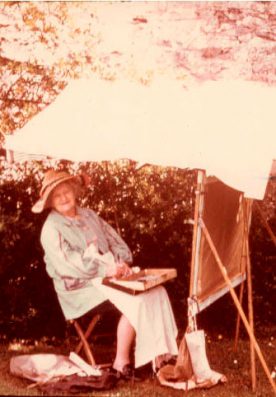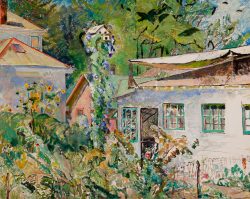Laura van Pappelendam, from a photograph circa 1959–1960, courtesy Anne Ryan, the artist’s grand-niece.

Laura van Pappelendam 1883–1974
Laura Peternellie van Pappelendam grew up in Keokuk, Iowa, with an ambition to be an artist. She enrolled in the Art Institute of Chicago in 1904 and graduated five years later from its teacher training department. While continuing her studies Van Pappelendam began a half-century of teaching at the Art Institute; she later also taught in the summer school of Illinois State Normal University (now Illinois State University) and at the University of Chicago. The artist’s most influential mentors included Spanish impressionist painter Joaquín Sorolla y Bastida, Russian artist Nicholas Roerich, and Ashcan School affiliate George Bellows, all of whom served as popular guest instructors at the Art Institute in the 1910s. In 1916, Van Pappelendam worked in the important artists’ colony in Provincetown, Massachusetts, with portrait painter Charles W. Hawthorne.
Van Pappelendam began exhibiting in the Art Institute’s various annual exhibitions in 1917. The following year she won the Goodman prize in the Art Students’ League of Chicago show, the first of many honors. She exhibited her work in numerous other venues both in Chicago and nationally, particularly between the mid-1920s and the early 1940s. Notwithstanding her abundant training in portrait and figure painting, van Pappelendam worked almost from the first in landscape, favoring scenes that incorporated architectural settings. Her loosely painted, brightly colored images often feature gardens, patios, porches, and courtyards adjacent to rustic buildings. When figures appear in her paintings they are unobtrusive, simply lending touches of local life to impressions of ordinary places that are charming in their unassuming authenticity. Van Pappelendam also made still-life images. She worked in a variety of painting media, including watercolor, pastel, and charcoal.
The artist found her subjects on travels to a variety of locales popular with American artists. In the 1920s she made repeated trips to Santa Fe, New Mexico. In 1930 she visited Cuernavaca, Mexico, to study with renowned muralist Diego Rivera, and in the following decade she traveled widely in Mexico, frequently painting in rural villages. Under Rivera’s influence, van Pappelendam’s style evolved from a decorative impressionism to a more expressionist mode. In the late 1930s and 1940s she spent summers in her hometown of Keokuk with her ailing stepmother and her aunt and in the 1950s she visited Dublin and Galway, Ireland. Never married, “Miss Van” was a devoted teacher with a reputation for encouraging young artists. Van Pappelendam died on her ninety-first birthday.
Wendy Greenhouse, PhD
